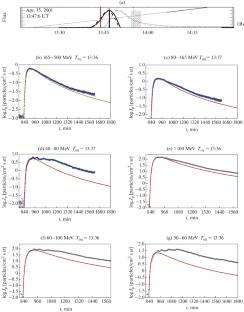比较不同方法获得的太阳质子事件中太阳质子释放次数的数据
IF 0.48
Q4 Physics and Astronomy
Bulletin of the Russian Academy of Sciences: Physics
Pub Date : 2025-07-15
DOI:10.1134/S1062873825711286
引用次数: 0
摘要
根据太阳质子事件时间剖面的尺度不变性确定的太阳非相对论性质子的释放时间,与通过速度色散和中子监测器的初始观测确定GLE事件中太阳相对论性质子的释放时间的研究结果进行了比较,考虑到太阳-地球磁力线的长度与太阳风速度的依赖关系。本文章由计算机程序翻译,如有差异,请以英文原文为准。

Comparing Data on the Times of Solar Proton Release in Solar Proton Events, Obtained in Different Ways
Times of the release of solar unrelativistic protons, determined from the scale invariance of temporal profiles of solar proton events, are compared to results from studies in which the times of release for solar relativistic protons in GLE events are determined through velocity dispersion and the initial observation on neutron monitors, allowing for the dependence of the length of Sun‒Earth magnetic lines on the velocity of the solar wind.
求助全文
通过发布文献求助,成功后即可免费获取论文全文。
去求助
来源期刊

Bulletin of the Russian Academy of Sciences: Physics
Physics and Astronomy-Physics and Astronomy (all)
CiteScore
0.90
自引率
0.00%
发文量
251
期刊介绍:
Bulletin of the Russian Academy of Sciences: Physics is an international peer reviewed journal published with the participation of the Russian Academy of Sciences. It presents full-text articles (regular, letters to the editor, reviews) with the most recent results in miscellaneous fields of physics and astronomy: nuclear physics, cosmic rays, condensed matter physics, plasma physics, optics and photonics, nanotechnologies, solar and astrophysics, physical applications in material sciences, life sciences, etc. Bulletin of the Russian Academy of Sciences: Physics focuses on the most relevant multidisciplinary topics in natural sciences, both fundamental and applied. Manuscripts can be submitted in Russian and English languages and are subject to peer review. Accepted articles are usually combined in thematic issues on certain topics according to the journal editorial policy. Authors featured in the journal represent renowned scientific laboratories and institutes from different countries, including large international collaborations. There are globally recognized researchers among the authors: Nobel laureates and recipients of other awards, and members of national academies of sciences and international scientific societies.
 求助内容:
求助内容: 应助结果提醒方式:
应助结果提醒方式:


